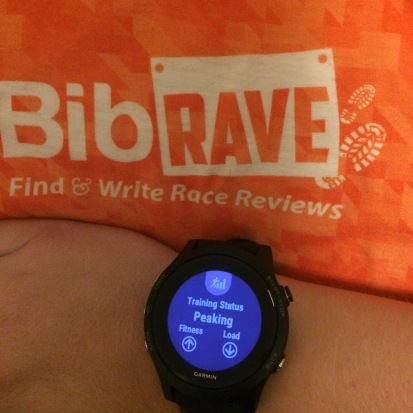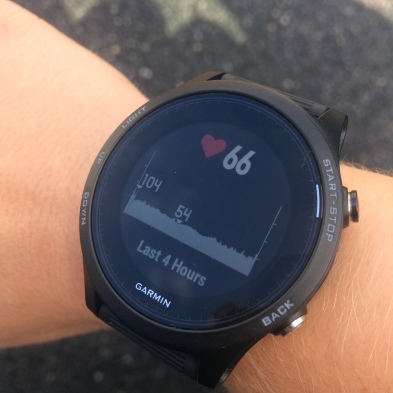Disclaimer: I received a Garmin Forerunner 935 Multisport GPS Watch from Garmin to review as part of being a BibRave Pro. Learn more about becoming a BibRave Pro (ambassador), and check out BibRave.com to review, find and write race reviews!

Five days before the Richmond Marathon, it was exciting to see the “Peaking” training status on my Garmin Forerunner 935 Multisport GPS Watch for the first time.
I had been wearing the watch for about two-and-a-half weeks, since I received it through BibRave, and this was the first time I’d seen that status. Although it went back to “Recovery” before I ran the race, it was still a confidence boost.
I’ve now had the watch for a little more than a month, and I have seen every status except for one. (See update below.)
Here’s what training status is, as described in the Garmin Forerunner 935 manual on the Garmin website: “Training status shows you how your training affects your fitness level and performance. Your training status is based on changes to your training load and VO2 max. over an extended time period. You can use your training status to help plan future training and continue improving your fitness level.” (If you click on the Garmin Forerunner 935 manual link above, you can go straight to this page to learn more.)
My normal training status setting seems to be “Productive,” but I think it’s interesting to see the changes in the status. The only one I haven’t seen so far of the seven statuses — Peaking, Maintaining, Recovery, Unproductive, Detraining and Overreaching — is “Unproductive.” (Update on Sunday, 11/25 – I’ve now seen all of them.) You can read about each status at the link above, too.
The watch is mine to keep, and I’m looking forward to using the Garmin Forerunner 935 for a full marathon training cycle. My next marathon is the Vermont City Marathon, which I will be running for BibRave.
Read on to learn more about the Garmin Forerunner 935 and some of what it does.
Widgets

The training status is just one of several widgets that can be accessed from the main screen. The watch user can choose which widgets show up, or to add widgets.
Heart Rate: Starting on the home screen, I can click the “down” button on the watch to see my current heart rate, along with a graph of my heart rate over the past four hours. If I click the “Start/Stop” button on the watch, I can see my average resting heart rate over the past week.
Training Status: Continuing down, the next widget is training status. If I click on the “Start/Stop” button, I can see my current VO2 Max, which has ranged from about 39 to 43 during the time I have had the watch. I’m hoping to improve this as I (hopefully) improve my speed during the next few months. If I click the “down” button from this screen, I can see the estimated recovery time based on my recent runs, my current training load and a race predictor.
I thought the race predictor was a little generous for my marathon and half marathon times, so I looked it up — the website does note that “This projection also presumes you have completed the proper training for the race.” Even though I do train for races, I don’t always do each part of training, such as speed work. So, I am looking at these as an ideal time that may be possible if everything goes perfectly and my training is more intense.
Runs: The next screen on my watch shows my latest run, along with the total mileage for the week. I can access data about my other runs by clicking the “Start/Stop” button.
Steps: The Garmin Forerunner 935 also tracks steps, and the next screen shows this. The watch sets a goal for me each day — I’m assuming that’s based on my other step totals. If I click the “Start/Stop” button, I can see how I’ve done with the goal each day.
Events, Notifications and Weather: The next three widgets rely on information taken from my phone — events (I don’t usually have too many set up on my phone), notifications (I turned these off because I usually have my phone with me anyway and I didn’t need to get so many Instagram notifications on my watch) and weather.
Wearability & Battery Life
I never pictured myself as the kind of person who would wear an athletic watch all the time. When I bought a step tracker a little more than a year and a half ago, I got one that would fit in my pocket because I didn’t think it would really match all my outfits. However, I feel comfortable wearing the Garmin Forerunner 935 all the time.

I have basically been wearing it nonstop since I received it. I have been wearing it to sleep, and it tracks sleep data. I’ve only been taking it off for yoga and showering. I wore it to yoga once, and the watch sometimes pushed against my hand when I did certain poses, and I feel like I shouldn’t be focusing on a watch during yoga. The watch is waterproof, so I could wear it for showering if I wanted to.
The battery life is also impressive. I hardly ever have to charge it, and when I do, it charges quickly. I did run a marathon with the watch earlier this month, and it wasn’t low on battery when I finished the race.
Using the watch for a run
The watch has the ability to track all kinds of activities, among them running, biking, swimming, triathlon, hiking, skiing, stand-up paddle boarding, rowing and golf. I did wear the watch for an indoor spin class one day, but in order to track data in real time, I would need to buy a sensor. (Read more about tracking indoor activities here.) I’ve also been wanting to wear the watch for an outdoor bike ride, which I will certainly do at some point.

I have used the Garmin Forerunner 935 to track plenty of runs.
Once I start running, the watch shows my cumulative time as well as my average pace. I can also hit the “down” button to see screens showing my lap time, current heart rate/zone and the time of day.
After about 0.6 miles (another BibRave Pro noted the time when this comes up and I started realizing the distance after that), the performance condition comes up on the watch. According to the Garmin website, “the performance condition feature analyzes your pace, heart rate, and heart rate variability to make a real-time assessment of your ability to perform compared to your average fitness level.”
I think this is an interesting feature, and if it’s high, that gives me confidence. I feel like I remember it being around a “+8” or so when I ran the Across the Bay 10K. When I’ve done slower runs — I lead a slower-paced group and I don’t always run super fast on my own anyway — the performance condition is closer to “baseline.”
At each mile, the watch vibrates and shows my time for that mile. I love that it vibrates because I never miss a mile — I can easily look down to check the mile time. It also vibrates to show the performance condition.

Once I’m finished with my run, I can see all kinds of data. The watch will show whether I am improving my aerobic and anaerobic fitness with a score from 0-5 for each category.
The run data can be accessed from the “Activities” widget I mentioned earlier. I can see the following categories under “Details”: distance, time, pace, calories burned, average heart rate, max heart rate, aerobic training effect, anaerobic training effect, cadence, ascent and descent.
I can also see my time per lap, a map, the training effect — for example, my data for the last run says I am “highly improving VO2 max” and “highly improving anaerobic fitness” (not every run is like that, though). On my most recent run, these scores were 4.9 and 4.4, respectively.
The Garmin Forerunner 935 also shows the time in each heart rate zone, which I think is interesting to look at because it shows something about my effort and how hard the run was. I know at the Seaside 10 Mile Run, I was in the red Zone 5 — the highest heart rate zone — for most of the run.

Another category is the elevation plot.
Garmin Connect
The watch syncs to my phone using the free Garmin Connect app. The Garmin Forerunner 935 syncs via Bluetooth, so I don’t have to plug it into my computer for it to transfer the data. I also have my Garmin Connect linked to Strava, so the runs show up automatically on there as well. If I have a problem with it syncing to Garmin Connect, I just close and restart the app, and that solves the problem.
On the app, I can look at various categories on the home screen, including heart rate, steps, intensity minutes, stress, calories and sleep. It also shows my run for the day. I’ve also connected with friends who also have Garmin watches through the app and have participated in some steps challenges with them.

The app also offers a place to customize the watch face, with plenty of options available in the Connect IQ store. I downloaded a free watch face to count down to the Richmond Marathon.
There is so much I could say about this watch, and it may be impossible to go into everything, at least in a blog post of a reasonable length. I feel like I am still learning about things the Garmin Forerunner 935 does. Other BibRave Pros’ posts will focus on different topics, and I encourage you to check out their posts here!
Interested in getting your own Garmin Forerunner 935? The watch retails for $499.99. Here’s a link to the Garmin website, where you can buy one. It’s the most expensive watch/piece of running equipment that I’ve owned, but it certainly does a lot and it is something I use every day.
I so agree with you on wearing it all the time. It’s so funny because before, I only put my Garmin on when I was going for a run. The battery would last for that and then I’d charge it up again before my next run. This one LASTS – and I love that. I think I’m going to have to get a new band to get fancy since I’ve been wearing it nonstop.
LikeLiked by 1 person
nice write up girlie!! 🙂
LikeLiked by 1 person
Thanks!! 🙂
LikeLike